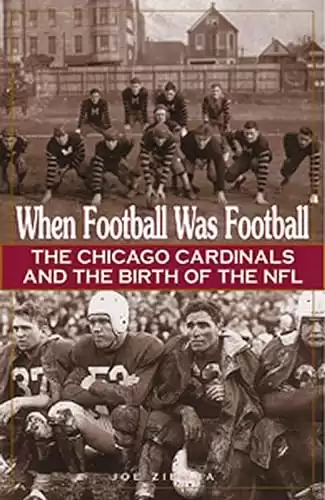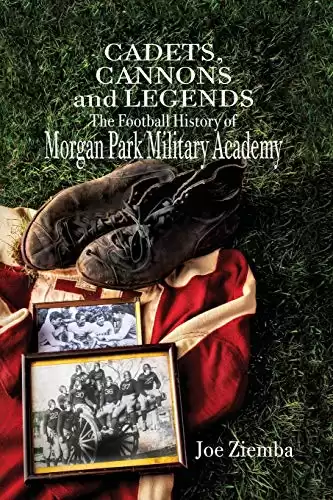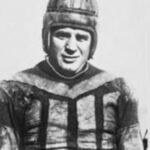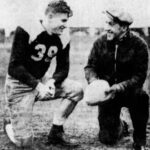George Halas, the founder and also coach of the Chicago Bears for many decades, is remembered for many reasons. He was an exceptional leader on the field who continually kept his club in contention for NFL honors and won several league titles himself.
He is recalled as one of the founders of the National Football League, while also remembered as being tough, frugal, and perhaps visionary. Bears fans adored him, Green Bay fans hated him, while Cardinals fans still blame him for forcing their team out of Chicago over 60 years ago!
But if George Halas should be remembered for anything, it should be his unselfish patriotism as a result of his stints in the service during two world wars. During World War I, Halas left the University of Illinois and enlisted in the U.S. Navy. In early 1918, Halas was assigned to the Great Lakes Naval Training Center just north of Chicago.
There, instead of being placed on a transport ship intended for the war zone in Europe, Halas spent his service tenure playing football, basketball, and baseball for the highly visible Great Lakes athletic program. Halas was never an impact player at Illinois but certainly blossomed at Great Lakes.
Due to an influenza outbreak in 1918, along with few colleges fielding a football team that year due to the war effort, Great Lakes found itself in the 1919 Rose Bowl. Playing alongside future Bears’ teammate, Paddy Driscoll, Halas was named the MVP of the Rose Bowl as Great Lakes defeated Mare Island, another service club.
However, the fact that Halas avoided combat during WWI, through no fault of his own, always bothered him. He enjoyed the opportunity to play sports at the highest level during his time in the military, but it always nagged him that he was unable to do more for his country.
And then at the height of his football powers in 1942, Halas left his team, home, and family to volunteer once again for the war effort during World War II. At the age of 47, Halas was likely too old for active duty and combat, but that was exactly what he was looking to achieve.
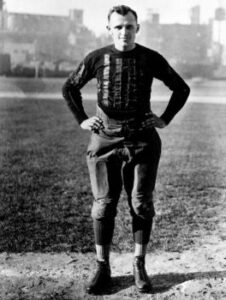
So, as we approach Memorial Day in 2022, we remember George Halas once again, not because he was lost in combat, but because of his unwavering effort to assist when his country was in need. In this episode of “When Football Was Football,” we’ll follow the decision that Halas made in 1942 to enter the service and how that choice affected his beloved Chicago Bears.
Would The Bears Survive Without Halas?
When the departure of Halas finally occurred, would the Bears falter and fail, or would the team react positively to a new set of leaders and coaches? After all, Halas controlled virtually every aspect of the Chicago Bears at that time, as he had since 1920.
The team would end up doing just fine, but for Halas, his personal entry into the war effort was intended to appease his inner drive to do more for his country. In his autobiography, Halas explained the situation following the Japanese attack on Pearl Harbor:
“The Japanese attack brought to the fore a commitment I had made to myself at the end of World War I. I had gone into the navy as a volunteer and asked for sea duty but the navy had assigned me to the sports program at the Great Lakes Naval Training Station, playing on the base teams and helping to coach football. On discharge, I pledged myself that if another war came, I would get myself where the action was. The time had come to make good that commitment.”
And the correct time for George Halas occurred right in the middle of the 1942 season. His club had captured two straight NFL titles and the Bears were off to a fantastic start in 1942 with a 4-0 record after also smashing through five opponents in exhibition games.
Included in that number was a 21-0 throttling of the College All-Stars before over 101,000 fans in Chicago on August 28. Halas would enjoy one final game prior to his departure when the Philadelphia Eagles were in town on October 25. Halas was due to be surprised at halftime by Lt. Commander Carl Olson with a jovial “goodbye” ceremony.
Difficult to Leave the Bears at This Time
The only problem was that Halas almost failed to show up! No one wanted to reveal the secret ceremony to Halas before the half, and during the break, he took longer than usual to explain the nuances of the game to his team which was nursing just a 17-7 lead. When he finally emerged on the field, the band broke out in a serenade of “For He’s a Jolly Good Fellow,” and Lt. Commander Olson took over the microphone and announced:
“If this is a surprise to George Halas, it will make us happy. The radio football audience and fans would deem it unwise if he left without some sort of ceremony. I speak for all the lovers of the great game of football when I say they admire and respect you for your energy and effort in putting professional football on the high plane it now enjoys in the sports world.”
Olson then presented Halas with a symbolic sword as the Bears’ coach prepared to leave for his initial assignment in Norman, OK. Halas was certainly touched by the gesture and said: “This indeed is a complete surprise and I do feel honored by this presentation and I wish to thank my friends.
As you all know, it is difficult to leave the Bears at this time, but nevertheless, I am looking forward to my naval duties. I hope I will be a credit to naval aviation.” He was likely even more pleased with the results of the game that day as the Bears scored four times in the second half and demolished the Eagles 45-14.
It was a nearly perfect day for the powerful Bears who were led by Hall of Fame quarterback Sid Luckman and the versatile halfback Frank Maznicki. The latter was a rookie halfback from Boston College who contributed a touchdown, a field goal, and three extra points.
Chicago piled up 415 yards overall to just 81 for the visitors and effectively blitzed the Eagles’ defense throughout the game with the Bears’ robust “T” formation.
Who Would Be The Bears Next Coach?
Within a week, Halas was officially reactivated on November 1, 1942, as a lieutenant commander. But what would happen to the Bears? The team was reveling in an 11-game NFL winning streak and appeared poised to easily grab a third straight professional crown.
But times were difficult for both the Bears and the NFL during wartime and Halas needed to make some tough decisions before his imminent departure. First and foremost, Halas would be faced with the challenging decision regarding who would replace him as the head coach. There were three very experienced, and capable, candidates already on the coaching staff in assistants Paddy Driscoll, Hunk Anderson, and Luke Johnsos.
Ultimately, all three would receive increased responsibilities during the absence of George Halas as reported in the Chicago Tribune: “George Halas turned over the responsibilities, worries, and the pleasure that goes with having a championship eleven to his three assistants.
To Luke Johnsos and Hunk Anderson, he willed the running of the team on the field, designating the pair as co-coaches. To Paddy Driscoll, he assigned many of the off-field duties, in addition to his regular post as backfield coach.”
In addition, club secretary Ralph Brizzolara would serve as the Bears’ new business manager and the Tribune speculated that the Halas replacements would break into their new roles quite easily due to the opposition in the very first game without their old, and future, boss: “On the surface, it appears that the new Bear administration will have a soft touch Sunday against the Detroit Lions, who have dropped six consecutive league games.”
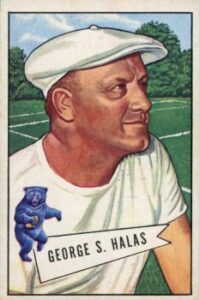
Bears Heavily Favored In 42' Title Game
Indeed, the 1942 version of the Chicago Bears may have been one of the strongest units in the team’s history, but the often-inept Lions proved to be a stern test for the Bears. The two teams battled to a scoreless deadlock through most of the first half until Ray McLean grabbed a 33-yard scoring toss near the end of the second quarter, providing the Bears with a 6-0 halftime edge over the stubborn Lions.
In the second half, Luckman connected with Harry Clark on a 26-yard touchdown pass and Lee Artoe added the extra point. In the fourth quarter, Maznicki booted a 16-yard field goal to enable the Bears to escape with a 16-0 victory.
Although the difficulty of the victory over the Lions was a bit of a surprise, the Bears plowed through the remainder of the schedule with five more easy victories and outscoring their opponents 183-14. With a solid 11-0 mark in the regular season, the Bears were heavily favored in the title tilt with the Washington Redskins (10-1).
The Boston Globe noted that the success of the undefeated Bears in 1942 has “let the betting boys to lay odds of 3-1 or three touchdowns on the Bears.” The game was sold out over a week in advance. With over 36,000 tickets gobbled up quickly, the league office simply stated: “Even Congressmen and government bigwigs [seeking tickets] were dismissed with the comment that everything was sold a week ago!”
Without Halas, the powerful Bears were still expected to easily brush aside the Washington club, which was pinning its hopes on quarterback Sammy Baugh. “He’s our ace,” said Washington coach Ray Flaherty, “and we’re going to use him as much as possible.”
Washington Throws Monkey Wrenches Into T Machine
But it all came crashing down for the Bears in that 1942 NFL championship game when the Redskins surprised the Bears 14-6 to derail Chicago’s two-year run as the NFL champion. The Bears’ exquisite “T” formation was crippled by the aggressive Washington defense.
In fact, the only score for the Bears occurred in the first quarter when big tackle Lee Artoe picked up a loose fumble and ran 45 yards for the only score by the losers. The Associated Press reported: “Before a sellout crowd of 36,000 strictly partisan fans the Redskin line threw monkey wrenches into the mighty Model T machine from Chicago that had rolled over its last 24 opponents in a row.
All the Bears’ pet plays, particularly the quick opening line smashes for which they are famous, were wrecked throughout the afternoon.”
The Bears and their fans were stunned by the surprising setback, but quarterback Sid Luckman was not afraid to publicly lament the shocking defeat and the missing influence from George Halas: “We were beginning to think of ourselves as unbeatable. Coach Halas would never have allowed that. He always told us we must go into every game prepared to meet a superior team. We did not work as before. The inevitable occurred. We ceased being the champions.”
Hunk Anderson and Luke Johnsos continued to lead the Bears through the 1945 season while Halas served his country. The pain of the Bears’ 1942 championship game debacle vanished when the co-coaches led the team to an 8-1-1 record in 1943. In the championship game, once again against Washington, the Bears secured a bit of sweet revenge when they blasted the Redskins 41-21 to secure another NFL crown.
We Signed Anyone Who Could Run Around The Field!
After posting marks of 6-3-1 in 1944 and then stumbling to a 3-7 finish in 1945, the Bears were looking less than invincible. Part of the problem on the field was the lack of qualified players, as Coach Johnsos estimated that the Bears had lost 19 of their 28 players due to military commitments.
He added: “We held tryouts at Cubs Park and signed up anybody who could run around the field twice. We had players forty years old, fifty years old. We had a very poor ball club but people were making a lot of money and audiences held up fairly well.”
The Bears welcomed back coach George Halas in 1946 and he was joined by many talented players who had also served in the war. The result was a complete turnaround from the 1945 campaign as the Bears ended the season with an 8-2-1 record. This qualified the Bears for another spot in the NFL title game, this time against the New York Giants.
Halas was not disappointed as his squad clubbed the Giants 24-14 in front of a record crowd of 58,346. It was the seventh championship won by the Bears, and the fourth in the 1940s, proving that Halas had not missed a step during his time away from the game.
Thank you for joining us for this episode of “When Football Was Football” and please stop by for the next program when we’ll continue our examination of the Chicago Bears with a closer look at that 1946 title. How did George Halas turn the team around so quickly, and how the heck do you reprimand a lineman for not hustling during wind sprints after he has just spent three or four years dodging bullets in service to his country?
Want more about George Halas? Learn about the different “retirements” he had or more about his life and even a mock interview on When Football Was Football.
Also, the episode you just heard marks the beginning of our third year on the Sports History Network and I’d like to thank Arnie Chapman, founder of the Sports History Network, for allowing me the opportunity to share some forgotten football history on this great platform!
Author and Host - Joe Ziemba
Joe Ziemba is the host of this show, and he is an author of early football history in the city of Chicago. Here, you can learn more about Joe and When Football Was Football, including all of the episodes of the podcast.
Please Note – As an Amazon Associate I earn from qualifying purchases
Resources
More From When Football Was Football
Paddy Driscoll’s Almost Perfect Season
Back at the beginning of the National Football League in...
Read More120,000 Fans Witness High School Football Game in 1937!!!
Let’s set the stage… It was a warm November afternoon...
Read MoreIn The Beginning: An Interview With Joseph T. Sternaman
And, you may ask, who is Joseph T. Sternaman? Sternaman...
Read More1948: The Last Hurrah of the Chicago Cardinals
Cardinals’ fans are familiar with the long, sad story concerning...
Read More